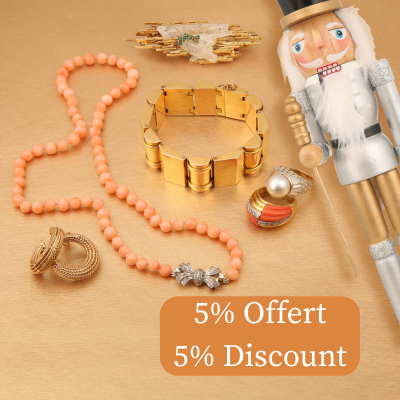Discover enamel and its techniques
From a sparkling scale to a fairy’s wings or a vine leaf, enamel and its techniques have captivated the Art Nouveau movement and continue to seduce us.

Many lovers of antique or art jewelry are familiar with enamel, but few know exactly this material and its specific techniques.
What is enamel?
Enamel is a melting material, which can be composed of various materials such as silica, feldspars or other metal oxides. During its heating (which can vary according to the materials used) the mixture will vitrify in a more or less opaque way.
Covering a material with enamel is called enameling and is a real skill.
What are the different techniques used ?
CLOISONNE ENAMEL
Known since Antiquity, this technique consists in fixing thin partitions of gold, silver or copper on the metal support by soldering, thus creating a network of cells which maintain the enamel in a precise way in the desired place. The enameling and finishing are similar to the champlevé technique.

Ornament of bodice end of the XIXth century

Bracelet designed by Fouquet drawn by Mucha for Sarah Bernard
CHAMPLEVÉ
The artist digs cavities in the thickness of the metal according to the planned design, using chisels and scoops. The wet powdered enamel is deposited in these cavities and then undergoes the firings that allow it to be fixed to the metal. The color is thus surrounded by the metal that the tool has spared, hence the name “sparing cut” which also applies to this technique. Successive sandings of finer and finer grain remove the excess enamel and give the piece the necessary polish. Gilding gives the piece its final appearance and makes it unalterable. Champlevé is the technique of the Limousin enamels of the Middle Ages.

Sphynx ring, Fouquet

Peacock brooch, Lalique
BASSE-TAILLE
The metal plate is engraved, hammered, chased or any other similar process. Translucent enamels are fired on the prepared support and allow mysterious and shimmering plays of transparency.

Watch Epure Tourbillon Fuchsia, Boucheron

Bretonne pendant by Vever
PAINTED ENAMEL
The plate is covered with flux on both sides and undergoes a first firing: the reverse side is thus protected from the attacks of time and the front side prepared to receive the decoration. The latter is obtained by superimposing numerous layers of colored enamel, applied with a spatula, which are fixed by an identical number of firings. Vitrifiable colors, crushed fine enough to be handled with a brush, can enhance certain details. Similarly, the application of thin gold or silver leaves, called “pearls”, embedded in the enamel, gives the color a particular brightness. The technique of painted enamel appeared in Limoges at the end of the 15th century.

Starry Night Bracelet, Frey Wille

Orchid Watch, Piaget
GRISAILLE
Derived from painted enamel, it consists in superimposing a white enamel on a black background. By scratching, using extremely fine tools, the artist obtains a very wide range of grays, which is admirably suited to the art of portraiture. It made Limoges famous during the Renaissance.
PLIQUE-À-JOUR ENAMEL
The plate is pierced through at the location of the colored surfaces. The enamel is housed in these openings and remains, after firing, apparent on the front and back of the plate. The effect is comparable to that of stained glass but on much smaller formats. The Master in the matter was René Lalique.

Necklace designed by Fouquet and drawn by Mucha
Dragonfly brooch, Lalique
What are the great names that have worked on it?
Among the great names in jewelry that have used and popularized enamel, we can undoubtedly mention René Lalique, Henri and Paul Vever and Georges Fouquet. Emblems of Art Nouveau jewelry, their use of enamel remains to this day what made all the beauty of the jewelry of this period with an enamel that imitated nature with perfection, from the delicacy of a leaf to the wings of a fairy.

Brooch Woman’s head, Fouquet

Julia Bartet’s stage tiara by Lalique

Butterfly pendant, VEVER
Nowadays enamel is not used as much but is still present, notably in the cross bracelets of Tiffany & Co, the head of the famous “Serpenti” model of Bulgari or in the decoration of watches such as the “Tourbillon” watch of Boucheron or the “Reverie Nocturne” of Chaumet.

Cross bracelet Tiffany & Co
If you are interested in enamelled jewelry, don’t hesitate to discover what Les Pierres de Julie has to offer in store…
We are also available for any free expertise of your jewels, for that you can send an email with your photos to contact@lespierresdejulie.com.
Whether you're interested in buying a piece of jewellery or a stone, a free jewelry appraisal or jewelry resale, Pierres de Julie welcomes you to its Parisian boutique in the Village Suisse, a stone's throw from the Ecole Militaire and the Esplanade des Invalides.
Nouveautés
- 18.000 €
- 18.000 €
- Unit price
- / per
- 11.500 €
- 11.500 €
- Unit price
- / per
- 1.800 €
- 1.800 €
- Unit price
- / per
- 4.500 €
- 4.500 €
- Unit price
- / per
Ne manquez aucune de nos actualités !
- Choosing a selection results in a full page refresh.
Thanks for subscribing!
This email has been registered!
Shop the look
Choose options












